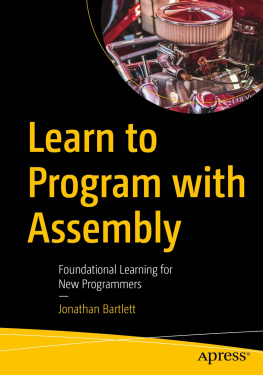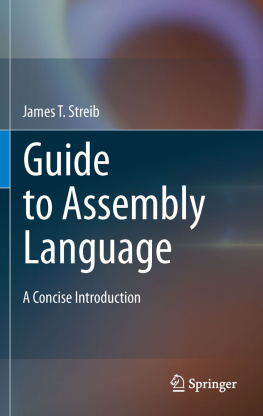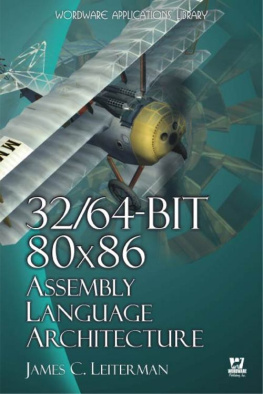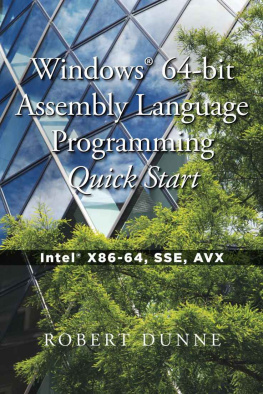Kip R. Irvine - Assembly Language for x86 Processors
Here you can read online Kip R. Irvine - Assembly Language for x86 Processors full text of the book (entire story) in english for free. Download pdf and epub, get meaning, cover and reviews about this ebook. year: 2019, publisher: Pearson, genre: Computer. Description of the work, (preface) as well as reviews are available. Best literature library LitArk.com created for fans of good reading and offers a wide selection of genres:
Romance novel
Science fiction
Adventure
Detective
Science
History
Home and family
Prose
Art
Politics
Computer
Non-fiction
Religion
Business
Children
Humor
Choose a favorite category and find really read worthwhile books. Enjoy immersion in the world of imagination, feel the emotions of the characters or learn something new for yourself, make an fascinating discovery.
- Book:Assembly Language for x86 Processors
- Author:
- Publisher:Pearson
- Genre:
- Year:2019
- Rating:3 / 5
- Favourites:Add to favourites
- Your mark:
- 60
- 1
- 2
- 3
- 4
- 5
Assembly Language for x86 Processors: summary, description and annotation
We offer to read an annotation, description, summary or preface (depends on what the author of the book "Assembly Language for x86 Processors" wrote himself). If you haven't found the necessary information about the book — write in the comments, we will try to find it.
Assembly Language for x86 Processors — read online for free the complete book (whole text) full work
Below is the text of the book, divided by pages. System saving the place of the last page read, allows you to conveniently read the book "Assembly Language for x86 Processors" online for free, without having to search again every time where you left off. Put a bookmark, and you can go to the page where you finished reading at any time.
Font size:
Interval:
Bookmark:

Eighth Edition
Kip R. Irvine
Florida International University
School of Computing and Information Sciences

Senior Vice President Courseware Portfolio Management: Marcia J. Horton
Vice President, Portfolio Management: Engineering, Computer Science & Global Editions: Julian Partridge
Executive Portfolio Manager: Tracy Johnson
Portfolio Management Assistant: Meghan Jacoby
Product Marketing Manager: Yvonne Vannatta
Field Marketing Manager: Demetrius Hall
Marketing Assistant: Jon Bryant
Managing Content Producer: Scott Disanno
Content Producer: Amanda Brands
Manufacturing Buyer, Higher Ed, Lake Side Communications, Inc. (LSC): Maura Zaldivar-Garcia
Inventory Manager: Bruce Boundy
Rights and Permissions Manager: Ben Ferrini
Full-Service Project Management: Vanitha Puela, SPi Global
Cover Image: Tetra Images/Alamy Stock Photo
Printer/Binder: LSC Communications, Inc.
IA-32, Pentium, i486, Intel64, Celeron, and Intel 386 are trademarks of Intel Corporation. Athlon, Phenom, and Opteron are trademarks of Advanced Micro Devices. TASM and Turbo Debugger are trademarks of Borland International. Microsoft Assembler (MASM), Windows Vista, Windows 7, Windows NT, Windows Me, Windows 95, Windows 98, Windows 2000, Windows XP, MS-Windows, PowerPoint, Win32, DEBUG, WinDbg, MS-DOS, Visual Studio, Visual C++, and CodeView are registered trademarks of Microsoft Corporation. Autocad is a trademark of Autodesk. Java is a trademark of Sun Microsystems. PartitionMagic is a trademark of Symantec. All other trademarks or product names are the property of their respective owners.
Copyright 2020, 2015, 2011, 2007, 2003 by Pearson Inc. 221 River Street, Hoboken, NJ 07030. All rights reserved. Manufactured in the United States of America. This publication is protected by Copyright and permissions should be obtained from the publisher prior to any prohibited reproduction, storage in a retrieval system, or transmission in any form or by any means, electronic, mechanical, photocopying, recording, or likewise. To obtain permission(s) to use materials from this work, please visit http://www.pearsoned.com/permissions/.
Previously published as Assembly Language for Intel-Based Computers.
The author and publisher of this book have used their best efforts in preparing this book. These efforts include the development, research, and testing of the theories and programs to determine their effectiveness. The author and publisher make no warranty of any kind, expressed or implied, with regard to these programs or the documentation contained in this book. The author and publisher shall not be liable in any event for incidental or consequential damages in connection with, or arising out of, the furnishing, performance, or use of these programs.
Microsoft and/or its respective suppliers make no representations about the suitability of the information contained in the documents and related graphics published as part of the services for any purpose. All such documents and related graphics are provided as is without warranty of any kind. Microsoft and/or its respective suppliers hereby disclaim all warranties and conditions with regard to this information, including all warranties and conditions of merchantability, whether express, implied or statutory, fitness for a particular purpose, title and non-infringement. In no event shall microsoft and/or its respective suppliers be liable for any special, indirect or consequential damages or any damages whatsoever resulting from loss of use, data or profits, whether in an action of contract, negligence or other tortious action, arising out of or in connection with the use or performance of information available from the services. The documents and related graphics contained herein could include technical inaccuracies or typographical errors. changes are periodically added to the information herein. Microsoft and/or its respective suppliers may make improvements and/or changes in the product(s) and/or the program(s) described herein at any time. Partial screen shots may be viewed in full within the software version specified.
Microsoft and Windows are registered trademarks of the microsoft corporation in the usa and other countries. screen shots and icons reprinted with permission from the microsoft corporation. This book is not sponsored or endorsed by or affiliated with the microsoft corporation.

ISBN-13: 978-0-13-538165-6
ISBN-10:0-13-538165-7
Assembly Language for x86 Processors, Eighth Edition, teaches assembly language programming and architecture for x86 and Intel64 processors. It is an appropriate text for the following types of college courses:
Assembly Language Programming
Fundamentals of Computer Systems
Fundamentals of Computer Architecture
Students use Intel or AMD processors and program with Microsoft Macro Assembler (MASM), running on recent versions of Microsoft Windows. Although this book was originally designed as a programming textbook for college students, it serves as an effective supplement to computer architecture courses. As a testament to its popularity, previous editions have been translated into numerous languages.
This edition includes topics that lead naturally into subsequent courses in computer architecture, operating systems, and compiler writing:
Virtual machine concept
Instruction set architecture
Elementary Boolean operations
Instruction execution cycle
Memory access and handshaking
Interrupts and polling
Hardware-based I/O
Floating-point binary representation
Other topics relate specially to x86 and Intel64 architecture:
Protected memory and paging
Memory segmentation in real-address mode
16-Bit interrupt handling
MS-DOS and BIOS system calls (interrupts)
Floating-point unit architecture and programming
Instruction encoding
Certain examples presented in the book lend themselves to courses that occur later in a computer science curriculum:
Searching and sorting algorithms
High-level language structures
Finite-state machines
Code optimization examples
This edition represents this books transition into the world of interactive electronic textbooks. Were very excited about this innovative concept, because for the first time readers will be able to experiment and interact with review questions, code animations, tutorial videos, and multiple-input exercises.
All section reviews in the chapters have been rewritten as interactive questions, giving the reader immediate feedback on their answers. New questions were added, others removed, and many revised.
Code animations allow the reader to step through program code and view both variable values and comments about the code. Readers no longer have to visually jump back and forth between program code and text explanations on the next page.
Font size:
Interval:
Bookmark:
Similar books «Assembly Language for x86 Processors»
Look at similar books to Assembly Language for x86 Processors. We have selected literature similar in name and meaning in the hope of providing readers with more options to find new, interesting, not yet read works.
Discussion, reviews of the book Assembly Language for x86 Processors and just readers' own opinions. Leave your comments, write what you think about the work, its meaning or the main characters. Specify what exactly you liked and what you didn't like, and why you think so.











